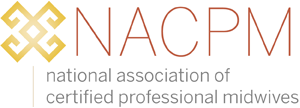Standards of Practice for NACPM Members
The NACPM member is accountable to the women she serves, to herself, and to the midwifery profession. The NACPM Philosophy and the NACPM Scope of Practice are the foundation for the midwifery practice of the NACPM member. The NACPM Standards of Practice provide a tool for measuring actual practice and appropriate usage of the body of knowledge of midwifery.
Standard One: The NACPM member works in partnership with each woman she serves.
The NACPM member:
Offers her experience, care, respect, counsel and support to each woman she serves
Freely shares her midwifery philosophy, professional standards, personal scope of practice and expertise, as well as any limitations imposed upon her practice by local regulatory agencies and state law
Recognizes that each woman she cares for is responsible for her own health and well-being
Accepts the right of each woman to make decisions about her general health care and her pregnancy and birthing experience
Negotiates her role as caregiver with the woman and clearly identifies mutual and individual responsibilities, as well as fees for her services
Communicates openly and interactively with each woman she serves
Provides for the social, psychological, physical, emotional, spiritual and cultural needs of each woman
Does not impose her value system on the woman
Solicits and respects the woman’s input regarding her own state of health
Respects the importance of others in the woman’s life.
Standard Two: Midwifery actions are prioritized to optimize well-being and minimize risk, with attention to the individual needs of each woman and baby.
The NACPM member:
Supports the natural process of pregnancy and childbirth
Provides continuous care, when possible, to protect the integrity of the woman’s experience and the birth and to bring a broad range of skills and services into each woman’s care
Bases her choices of interventions on empirical and/or research evidence, verifying that the probable benefits outweigh the risks
Strives to minimize technological interventions
Demonstrates competency in emergencies and gives priority to potentially life-threatening situations
Refers the woman or baby to appropriate professionals when either needs care outside her scope of practice or expertise
Works collaboratively with other health professionals
Continues to provide supportive care when care is transferred to another provider, if possible, unless the mother declines
Maintains her own health and well-being to optimize her ability to provide care.
Standard Three: The midwife supports each woman’s right to plan her care according to her needs and desires.
The NACPM member:
Shares all relevant information in language that is understandable to the woman
Supports the woman in seeking information from a variety of sources to facilitate informed decision-making
Reviews options with the woman and addresses her questions and concerns
Respects the woman’s right to decline treatments or procedures and properly documents her choices
Develops and documents a plan for midwifery care together with the woman
Clearly states and documents when her professional judgment is in conflict with the decision or plans of the woman
Clearly states and documents when a woman’s choices fall outside the NACPM member’s legal scope of practice or expertise
Helps the woman access the type of care she has chosen
May refuse to provide or continue care and refers the woman to other professionals if she deems the situation or the care requested to be unsafe or unacceptable
Has the right and responsibility to transfer care in critical situations that she deems to be unsafe. She refers the woman to other professionals and remains with the woman until the transfer is complete.
Standard Four: The midwife concludes the caregiving partnership with each woman responsibly.
The NACPM member:
Continues her partnership with the woman until thatpartnership is ended at the final postnatal visit or until she or the woman ends the partnership and the midwife documents same
Ensures that the woman is educated to care for herself and her baby prior to discharge from midwifery care
Ensures that the woman has had an opportunity to reflect on and discuss her childbirth experience
Informs the woman and her family of available community support networks and refers appropriately.
Standard Five: The NACPM member collects and records the woman’s and baby’s health data, problems, decisions and plans comprehensively throughout the caregiving partnership.
The NACPM member:
Keeps legible records for each woman, beginning at the first formal contact and continuing throughout the caregiving relationship
Does not share the woman’s medical and midwifery records without her permission, except as legally required
Reviews and updates records at each professional contact with the woman
Includes the individual nature of each woman’s pregnancy in her assessments and documentation
Uses her assessments as the basis for on-going midwifery care
Clearly documents her objective findings, decisions and professional actions
Documents the woman’s decisions regarding choices for care, including informed consent or refusal of care
Makes records and other relevant information accessible and available at all times to the woman and other appropriate persons with the woman’s knowledge and consent
Files legal documents appropriately.
Standard Six: The midwife continuously evaluates and improves her knowledge, skills and practice in her endeavor to provide the best possible care.
The NACPM member:
Continuously involves the women for whom she provides care in the evaluation of her practice
Uses feedback from the women she serves to improve her practice
Collects her practice statistics and uses the data to improve her practice
Informs each woman she serves of mechanisms for complaints and review, including the NARM peer review and grievance process
Participates in continuing midwifery education and peer review
May identify areas for research and may conduct and/or collaborate in research
Shares research findings and incorporates these into midwifery practice as appropriate
Knows and understands the history of midwifery in the United States
Acknowledges that social policies can influence the health of mothers, babies and families; therefore, she acts to influence such policies as appropriate

